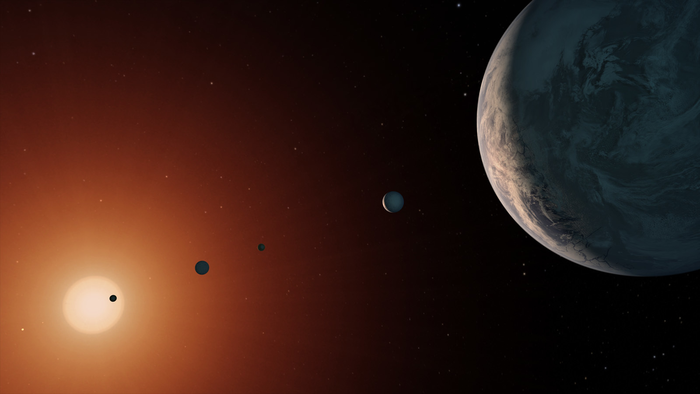Scientists uncover secrets of alien worlds using ‘perfect harmony’ of planetary system

Your support helps us to tell the story
From reproductive rights to climate change to Big Tech, The Independent is on the ground when the story is developing. Whether it's investigating the financials of Elon Musk's pro-Trump PAC or producing our latest documentary, 'The A Word', which shines a light on the American women fighting for reproductive rights, we know how important it is to parse out the facts from the messaging.
At such a critical moment in US history, we need reporters on the ground. Your donation allows us to keep sending journalists to speak to both sides of the story.
The Independent is trusted by Americans across the entire political spectrum. And unlike many other quality news outlets, we choose not to lock Americans out of our reporting and analysis with paywalls. We believe quality journalism should be available to everyone, paid for by those who can afford it.
Your support makes all the difference.Scientists have used the “perfect harmony” of a distant planetary system to understand more about its past.
The star Trappist-1 is best known for being at the heart of what Nasa called a “holy grail” solar system that looked remarkably like Earth. Since that discovery was first announced in 2017, astronomers have found yet more information about the system, including that it contains more planets and could be a home to life.
Scientists are still discovering more about those worlds, despite their vast difference from Earth, however. In new research, astronomers have used the “near-perfect harmony” of the orbits of the seven planets in Trappist-1 system to better understand their past.
The harmony refers to the astonishing neatness of the orbits of the various planets in the system. They are organised in precise ratios, much like the arrangement of harmonious musical notes: for every eight years on one planet, five years pass on the next one along, and they continue in such precise relationships.
The new research allows scientists to better understand the impact history of those planets, or what crashes they might have had to undergo when they were in their infancy. Doing so can help better characterise whether planets could have the water and other materials required for life to begin.
“After rocky planets form, things bash into them,” said astrophysicist Sean Raymond of the University of Bordeaux, in a statement. “It’s called bombardment, or late accretion, and we care about it, in part, because these impacts can be an important source of water and volatile elements that foster life.”
Studying those impacts is difficult enough on Earth, and must be done by measuring particular elements and comparing them with the makeup of meteorites. Doing so is clearly impossible in a system like Trappist-1, which is 40 light years away — and so scientists had to rely on more complex methods.
“We’ll never get rocks from them,” said Raymond. “We’re never going to see craters on them. So what can we do? This is where the special orbital configuration of TRAPPIST-1 comes in. It’s a kind of a lever we can pull on to put limits on this.”
Researchers were able to estimate how much bombardment the planets would have been able to undergo before they would be knocked out of that neat and resonant harmony. That helps establish what could have happened to those planets.
“We can’t say exactly how much stuff bashed into any of these planets, but because of this special resonant configuration, we can put an upper limit on it,” Raymond said. “We can say, ‘It can’t have been more than this.’ And it turns out that that upper limit is actually fairly small.
“We figured out that after these planets formed, they weren’t bombarded by more than a very small amount of stuff,” he said. “That’s kind of cool. It’s interesting information when we’re thinking about other aspects of the planets in the system.”
The findings help scientists begin to tell the story of the Trappist-1 planets. They must have formed early and fast — about ten times quicker than the Earth — but not been bombarded too much, which helps understand what might be inside those worlds and how its atmosphere could have formed.
But scientists note that there is much more to learn about the system. Future examination by projects such as the upcoming James Webb Space Telescope could help get rid of some of the unknowns in the new research.
Join our commenting forum
Join thought-provoking conversations, follow other Independent readers and see their replies
Comments